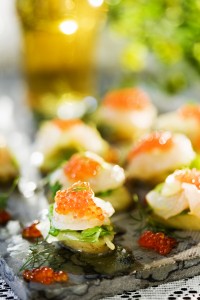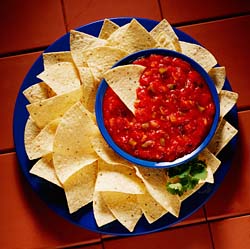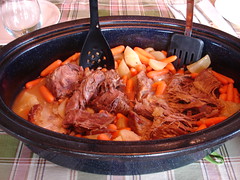Broiled Salmon in a Mustard Seed Crust
- At June 21, 2011
- By Katherine
- In News, Recipes
 0
0
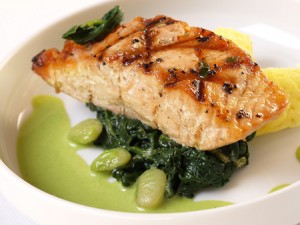 Broiled or Grilled Salmon in a Mustard Seed Crust
Broiled or Grilled Salmon in a Mustard Seed Crust
From: “Diet Simple: 195 Mental Tricks, Substitutions, Habits & Inspirations” (June 2011, LifeLine Press)
8 3-ounce servings
One Salmon Fillet, about 1.5 pounds
1/2 cup dried mustard seeds
1/2 bunch fresh dill, lightly chopped
1/2 medium sweet onion, thinly sliced
2 Tablespoons extra virgin olive oil
salt and freshly ground pepper to taste
For broiling
Lay the side of salmon flesh side up, salt and pepper liberally, and coat with the mustard seeds, then cover with the chopped dill, followed by thinly sliced raw onions. Finish with a sprinkling of olive oil. Preheat the broiler. Place the rack about 4 inches from the heat source. Broil the salmon under the broiler for about 10 minutes until the onions are brown and crispy, then turn the temperature down, keeping the salmon in the oven until the salmon is opaque all the way through. Use a thin knife to check the doneness of the flesh near the bone. Remove the fillet just before it is finished cooking, so that it does not overcook. I serve it right out of the oven or as chilled leftovers on subsequent days. This is a stunner for a party or a perfect “batch” meal for you and your family. The salmon may be served whole or individually portioned by cutting into vertical strips approximately two inches wide. 240 calories per serving.
“Grilled Salmon in a Mustard Seed Crust” is adapted from Patrick O’Connell’s The Inn at Little Washington, A Consuming Passion (Random House, 1996)
Alternative Grilling Instructions from Chef Patrick O’Connell:
Remove the rack from your charcoal grill and ignite the charcoal. Sprinkle the wood chips on top of the fire, letting the flames subside to glowing embers. Lay your rack on the top of the flesh side of the fish. Pressing the onions, dill and seasonings in place with the rack, quickly flip the rack over the fire with the skin side facing up. Lower the lid if your grill has one and cook for 10 minutes. The fish will continue to cook somewhat after it is removed from the fire. To remove the fish from the fire use tongs or oven mitts to lift off the grill rack with the fish in place and set on a large metal tray or cookie sheet to cool. Gently remove the skin.
Salmon is high in Omega-3-Fatty Acids.
Omega 3s are superstars. They are to the world of fatty acids what Tiger Woods is to golf, Lance Armstrong is to cycling, or Placido Domingo is to opera. Everyone’s heard about the importance of Omega-3s. While the full scope of their powers are still the subject of fierce debate among researchers, nobody challenges their importance or that Americans simply don’t get enough.
It’s been well-established that omega-3 fatty acids, a type of polyunsaturated fat found primarily in seafood, can improve your chances of living longer if you have heart disease. But its healing powers don’t stop there. Other organs may benefit. They have a positive impact from the womb to old age.
Omega 3’s reach is vast and the health benefits are intriguing the scientific community. While not an answer to every ailment, omega 3s are essential nutrients in the human body. Studies show that omega 3s may have significant physiological and psychological benefits.
In fact, Omega-3s are so important to human health, the National Academy of Sciences Food and Nutrition Board recently set a minimum daily requirement for the first time. For years we thought there was only one essential fatty acid, Omega 6 fatty acid (found in vegetable and soybean oils), but now scientists have added omega 3 to the list of essential nutrients humans must get from the diet.
I first became interested in the power of Omega 3 when psychiatrists I work with began prescribing it for their depressed patients, finding it made positive improvements. Then I started hearing about its potential benefits for arthritis and other inflammatory diseases. Could it be possible that one nutrient could provide so many benefits?
Najmieh’s Yogurt and Spinach Dip
- At June 21, 2011
- By Katherine
- In News, Recipes
 0
0
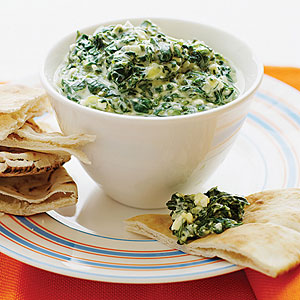 Najmieh Batmanglij’s Yogurt and Spinach Dip
Najmieh Batmanglij’s Yogurt and Spinach Dip
From “Diet Simple: 195 Mental Tricks, Substitutions, Habits & Inspirations” (June 2011, LifeLine Press)
8 Servings
4 Cups (10 Ounces) fresh Spinach, washed and chopped, or 1 cup frozen Spinach, thawed
2 Onions, peeled and thinly sliced
2 cloves garlic, peeled and crushed
2 Tbsp Olive Oil
1-1/2 Cups Low-Fat Drained Yogurt * or Greek Yogurt
1/2 tsp salt
1 tsp freshly ground Black Pepper
Garnish (optional):
1/4 tsp saffron dissolved in 1 Tbsp Hot Water
1 Tbsp Rose Petals
In a non-stick skillet, lightly brown the onions and garlic in 2 tablespoons oil for 20 minutes over medium heat. Add the spinach, cover and steam for about 5 to 10 minutes, until the spinach leaves are wilted. Remove from heat and let cool. In a serving bowl, mix yogurt and spinach and season to taste with salt and pepper. Refrigerate for several hours before serving. Garnish with saffron water and rose petals. Serve as a appetizer with crudites, whole grain crackers, or lavash bread. 130 Calories Per Serving.
“Yogurt and Spinach Dip” is from Persian Cooking for a Healthy Kitchen by Najmieh Batmanglij (Mage Publishers)
Yogurt is a Superfood, I am beginning to believe, based on current research, yogurt may be one of the best overall foods you can eat! Yogurt creates a natural way to boost your immune system by increasing the healthy bacteria in your gastrointestinal tract, according to my friend and colleague, Jo Ann Hattner, MPH, RD, in her book, “Gut Insight.”
Of course, many of the oldest civilizations in the world have known about yogurt for thousands of years.
For aging intestinal tracts, and as a bonus, increase your intake of calcium, protein, potassium, magnesium and other essential nutrients, eat fermented dairy or soy products, such as yogurts and kefir with live, active cultures, often labeled as “probiotics.”
Probiotics are live bacteria that promote digestive health. As we age, it is thought that bacterial populations in our gut change – resulting in increased harmful, disease-causing bacteria and fewer protective bacteria. When you add probiotics you repopulate the gut with beneficial bacteria that protect against infection-causing toxins.
You also improve colon health by lowering pH of the colon, so it’s receptive to the beneficial bacteria and detrimental to the disease-causing bacteria, you protect the intestinal lining, and strengthen immunity. Exciting research is evolving on the health benefits of probiotics.
(Reference: Mitsuoka T. Intestinal flora and aging. Nutr Rev. 1992 Dec;50(12):438-46)
More information on boosting your immune system…
Chickpea Salad with Cumin and Mint
- At June 21, 2011
- By Katherine
- In News, Recipes
 0
0
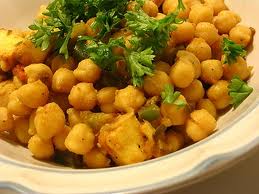 East Coast Grill and Raw Bar’s Chickpea Salad with Cumin and Mint
East Coast Grill and Raw Bar’s Chickpea Salad with Cumin and Mint
From “Diet Simple: 195 Mental Tricks, Substitutions, Habits & Inspirations” (June 2011, LifeLine Press)
Serves 4
1 cup dried chickpeas or 1 15-ounce can chickpeas
1/2 teaspoon Salt (if using dried chickpeas)
1/3 Cup Olive Oil
1/4 Cup Fresh Lemon Juice (about 1 lemon)
1 Tbsp Minced Garlic
1 Red Bell Pepper, halved, seeded, and diced medium
1/2 Cup Roughly Chopped Scallions (white and green parts)
1/4 Cup Roughly Chopped Fresh Mint
2 Tbsp Cumin Seeds, toasted if you want, or 1 Tbsp Ground Cumin
1 Tbsp Minced Jalapeno or other fresh chile pepper of your choice (optional)
2 Bunches Watercress, trimmed, washed, and dried
If you are using dried chickpeas place them in a large pot, cover with water, and let soak overnight, or for at least 5 hours. Drain and rinse two or three times. Return the chickpeas to the pot, cover with water again, add salt, and bring to a boil over high heat. Immediately reduce the heat to medium and simmer for one hour to one hour and 15 minutes, or until the chickpeas are tender but not mushy. Drain and rinse thoroughly with cold water. If you are using canned chickpeas, simply drain and rinse them. Place the chickpeas in a medium bowl, add all the remaining ingredients except the watercress, and toss well. Cover and refrigerate until well chilled, at least 30 minutes. When chilled, place the watercress on a platter or individual serving plates, top with the chickpea salad, and serve. 370 calories per serving.
“Chickpea Salad with Cumin and Mint” is from: License to Grill, copyright by Chris Schlesinger and John Willoughby (William Morrow and Company, Inc. 1997)
Chickpeas and other legumes, are not only delicious and versatile foods, they are loaded with nutrients which improve your body’s immune response, allowing you to resist diseases more effectively. They are high in protein (6 grams per 1/2 cup), 7 grams of fiber (the kind which lowers bad – LDL – cholesterol), high in iron, folate, vitamin E, only about 2 grams of healthy fat, and virtually zero sodium.
Scandinavian Midsummer: Feast the Night Away
- At June 13, 2011
- By Katherine
- In News, Recipes
 4
4
I’ve had a life-long love affair with Sweden, its culture, cuisine, and people. I’m so grateful that finally the world has caught on that my beloved Sweden is a recognized culinary destination.
Swedish cuisine is the ultimate “nouvelle” cuisine. It is simple, fresh, and is naturally local and seasonal. It’s elegant, yet down-to-earth, which is also a perfect description of the Swedish people, and even Swedish design.
The daughter of a Swedish mother and an American father, I’ve been visiting Sweden since a little girl. During my regular visits, I soaked in every possible aspect of Swedish food and cooking. I took many fishing trips in the Baltic Sea on my Uncle Olle’s small motor boat. I received early lessons on cleaning, smoking, grilling, pickling – and any method one could name – of preparing fresh fish.
I was raised in the Swedish culinary tradition. I’ve picked wild blueberries, strawberries and mushrooms in the Swedish archipelago, then watched as my grandmother (mormor) and Aunt Ingrid prepared treats with the bounty. Growing up, I and my mother dined regularly on crepes with lingonberries and cream – one of my favorite dinners (though now I use yogurt instead of cream! Naturligtvis!). I’ve delighted in all the unique foods my family introduced me to: the grainy rye breads, the special cheeses and yogurts, the smoked reindeer meat, the delicate, sweet, and tiny Swedish shrimps, caviar, crayfish, and of course, meatballs and lingonberry sauce!
If you are not a Swede or Scandinavian, you may not know that summer is the most special time of year. For weeks on end the sun never sets in Sweden’s summertime. It’s daylight round-the-clock.
Every year, during one of those “white nights” – the Friday nearest the 24th of June – the nation turns out to feast until morning. After long winter months of what seems like never-ending darkness, sun-starved Swedes join the rest of Scandinavia in celebrating the summer solstice – the year’s longest day.
Swedes call the celebration Midsummer Eve.
 It is more than just a holiday, however. Midsummer Eve, often lasting through Saturday – and sometimes the whole weekend – is the national excuse for the biggest parties of the year. The revelry is non-stop.
It is more than just a holiday, however. Midsummer Eve, often lasting through Saturday – and sometimes the whole weekend – is the national excuse for the biggest parties of the year. The revelry is non-stop.
Beginning Friday morning, families gather to set the scene. Every spare piece of furniture is moved outdoors, setting up a festival atmosphere. Large wooden crosses are turned into maypoles decorated with flowers, ribbons and leafy branches.
The maypoles are raised, and hours of dancing, singing and community wide camaraderie get under way. By late afternoon the revelry has served its purpose. Gnawing hunger has prepared the celebrants for the main event: the feast, Sweden’s famed smorgasbord.
Smorgasbord is a Swedish invention and is literally a table of open-faced sandwiches. Though its origin was a simple array of hors d’oeuvres, smorgasbords today are exhaustive buffet-style spreads, the Swedish version being the best known.
There are appetizers, salads, main courses and desserts. The dishes signal summer’s first harvests: freshly clipped dill, tender root vegetables, fish and other seafoods, and strawberries grown in the country.
There are cured ingredients, as well. Pink rolls of cured salmon are wrapped around dill sprigs, with yellow mustard sauces and peppercorns alongside. There is marinated herring and coarse salt, as well as dill and other pickles. Dairy products also are important, including eggs, cheese and cream.
The traditional drink is aquavit, Swedish vodka spiced with anise and caraway. It is served in tiny schnapps glasses. The Midsummer toast, which loses something in translation, usually amounts to a unanimous gulp followed by a chant of “rah, rah, rah, rah.”
Actually, preparation of Midsummer food usually begins a couple of days before. Local fishermen stack their just-caught salmon in rickety wheelbarrows, roll them into town and go door to door displaying their wares for inspection by anxious cooks.
The fish are carefully examined in solemn transaction, the cook – usually my Grandmother – signaling the final selection with an abrupt, “This will do!” The fisherman nods, satisfied, and carries the fish to the kitchen where it lands on the table with a thud. The smell of the sea enters the house with the day’s catch. The best knife has been sharpened for this moment: the start of Midsummer Eve cooking.
Aquavit and Marcus Samuelsson’s Gravlax Club Sandwich
Gravlax and Mustard Sauce
Dark Chocolate Dipped Strawberries
- At May 20, 2011
- By Katherine
- In News, Recipes
 1
1
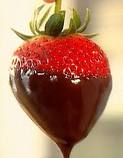 Dark Chocolate-Dipped Strawberries
Dark Chocolate-Dipped Strawberries
Serves 6 – 8
Ingredients:
For the Fondue:
½ cup Skim Milk
8 ounces Semisweet Chocolate, finely chopped
1 teaspoon Vanilla Extract
To Serve:
2 quarts Whole Strawberries (or other seasonal fruit, liked sliced pears)
Long toothpicks or Kebab Sticks
Finely Chopped Nuts (optional)
Course Ground Coffee (optional)
Granola (optional)
Heat the milk in a double boiler. When the milk begins to bubble around the edges, turn off the heat, and whisk in the dark chocolate chips. When melted, mix in the vanilla. Be careful not to burn the chocolate! Keep it on very low heat or in a double boiler. Pour into a fondue pot, keep on low, stirring occasionally. Spear each strawberry or piece of fruit with a long toothpick or kebab stick, and dip into the chocolate. If desired, roll in a bowl of chopped nuts, granola – or for the adults: course ground coffee for “mocha” dipped strawberries. To harden the chocolate, place each chocolate-dipped strawberry separately on parchment paper and let cool. About 160 calories per serving, which is 1/8 of the recipe. The strawberries are only 2 to 6 calories each, depending on their size.
Is it true that a chocolate a day will keep the doctor away?
The cacao bean, grown mainly in Latin America, Africa and Asia, is loaded with beneficial compounds. In fact, its early uses, dating back 3,000 years were mainly medicinal. It has been highly prized for centuries, which is reflected in its scientific name, Theobroma cacao, meaning “Food of the Gods.”
Cocoa, if high in flavanols, the beneficial plant compounds scientists believe impart most of cocoa’s benefits, may help maintain a healthy vascular system, relax blood vessels, reduce blood clotting – an aspirin-like affect –reduce oxidative damage, inflammation, and improve blood flow. All of which reduces heart disease risk.
If you’re eating chocolate for health benefits, you’ll need to be very discriminating in your selections. You’ll get more flavanols, and therefore health benefits, with less processing. The first choice is cocoa, which isn’t Dutch processed – as when cocoa is “Dutch processed with alkali” the flavanols are reduced. Look for chocolate which has the highest percentage of cocoa as possible and to save calories, look for chocolate with lower fat and sugar levels. In general, cocoa is your best first choice. Second choice is a semisweet or bittersweet chocolate with a high cocoa percentage. Some chocolates go as high as 85% cocoa, but legally can be as low as 35%. I recommend no more than an ounce a day, which may be about 110 – 150 calories, depending on the chocolate. Any more than that and you’re probably going to take in too many calories for weight control.
Did you know that there are 200 seeds on each strawberry?
Strawberries are members of the Rose family and there are over 600 different varieties. Choose freshly picked, ripe berries, as they will be the tastiest and will have the most nutrients. “Look for berries fully formed, bright red, without bruising or soft spots and with fresh-looking green caps,” says Janie Hibler in “The Berry Bible.”
Strawberries are considered a “superfood.” They have one of the highest antioxidant and nutrient contents of all foods, yet they are low in calories, so you can eat them in unlimited quantities. In fact, for your health, the more the better! “A serving of eight strawberries contains more vitamin C than an orange. Strawberries are also rich in folate, potassium, and fiber. They’re especially high in cancer- and heart-disease-fighting phytonutrients (beneficial plant compounds) called flavonoids, anthocyanins, ellagic acid, quercetin, catechin, and kaempferol,” according to David Grotto in “101 Foods That Could Save Your Life.”
“Addictive” Chilled Asparagus in a Creamy Tarragon, Shallot and Roasted Walnut Vinaigrette
- At May 12, 2011
- By Katherine
- In News, Recipes
 2
2
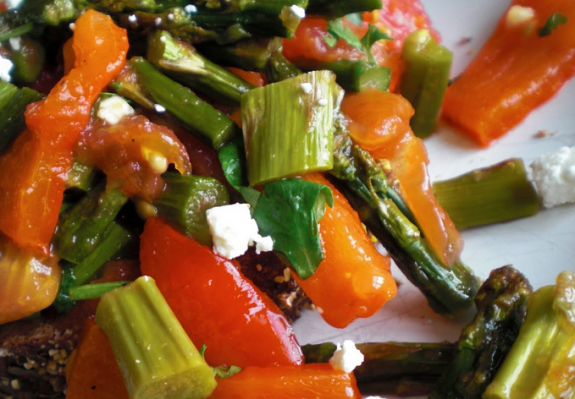
My favorite asparagus recipe is one I developed with my client, Rebecca. We made a mess in her kitchen with several bundles of asparagus in each corner. We roasted it, steamed it, and sauteed it. We tried a variety of dressings and accompaniments. The result? “Chilled Asparagus in a Creamy Tarragon, Shallot, and Roasted Walnut Vinaigrette.”

Cindy Mize during her (big, gorgeous hair and) non-vegetable-eating days in Washington, D.C. in 1986
Chilled Asparagus in a Creamy Tarragon, Shallot, and Roasted Walnut Vinaigrette
How delicious is this recipe? Let me just say my friend Cindy Mize – who recently lost 30 lbs with my DIET SIMPLE batch recipes, and who I immortalized in my book, Diet Simple, as having just lipstick and fingernail polish in her refrigerator (during her younger days in Washington), says she can’t sleep knowing it is in her refrigerator. In her new life as president of Miami Capital Properties in Key Biscayne, Florida, she has many dinner parties at which my asparagus recipe is featured. After her dinner guests leave, she says she sneaks to the refrigerator at midnight to scarf up the leftover. I can hardly believe the transformation of this southern gal who claimed she would only eat “brown” or “white” food: but I guess that illustrates the power of a great recipe!
Serves 6 to 8
Ingredients:
2 pounds Asparagus, cleaned, tough ends removed, cut in bite-sized (1.5 inch) pieces
1 Tablespoon Walnut or Canola Oil
A pinch of Salt and Pepper to taste
2 Ounces (1/2 Cup) Roasted, Unsalted Walnuts, Chopped
1 Small (4 ounce) Red Bell Pepper, Chopped Finely (roasted, if you wish)
1 Bunch (1/4 Cup) Green Onions, Chopped Finely
Vinaigrette:
2 Tablespoons Tarragon Vinegar (ideally – or regular vinegar)
4 Tablespoons Walnut Oil (ideally – or canola oil if walnut oil is not available)
2 Tablespoons Low Fat Greek Yogurt
1 Shallot, Chopped Finely
2 Tablespoons Fresh Tarragon, Chopped Finely
1 Tablespoon Fresh Parsley, Chopped Finely
1 Tablespoon Fresh Chives, Chopped Finely
¼ Teaspoon Salt
Freshly Ground Pepper, To Taste
Preparation:
First, prepare the vinaigrette by mixing all vinaigrette ingredients in a bowl large enough to fit the asparagus, red pepper and green onions. Place the bowl with the vinaigrette in the refrigerator so that it is cool when the asparagus comes out of the oven.
If you are using raw walnuts, toast the walnuts by placing them in a single layer on a baking sheet in a 350 degree oven for 8 to 10 minutes until light golden brown. Let them cool. Chop.
Preheat oven to 425 degrees.
Clean the asparagus, break off tough ends. If you wish, peel the stalks for a more tender vegetable. Slice the asparagus stalks diagonally into bite-sized or approximately 1.5 inch pieces. In a large bowl or plastic bag, toss the Asparagus pieces in 1 Tablespoon of Walnut or Canola Oil and a light sprinkling of salt and pepper until the asparagus is coated lightly with oil.
Place the oil coated asparagus on a baking sheet (parchment paper helps prevent sticking) in a single layer and cook for 5 minutes in the middle of the 425 degree oven. Pour the hot asparagus into the cool vinaigrette to help discontinue the cooking of the asparagus, so that it remains al dente. Do not overcook! Add the finely chopped red bell pepper, green onions, and nuts. Toss and serve immediately while still warm or chilled.
About 1,000 calories for the entire dish.
Asparagus is packed with nutrients. Low in calories, it’s an excellent source of folic acid and Vitamin C, Thiamin, and Vitamin B6. Asparagus, like other fruits and vegetables, is sodium-free, and contains no fat or cholesterol, either. It is an important source of potassium and many nutrients, important for boosting your immune system and preventing heart disease, lowering blood pressure and even preventing cancer. According to the National Cancer Institute, Asparagus is the highest tested food containing Glutathione, one of the body’s most potent cancer fighters. Additionally, Asparagus is high in Rutin, which is valuable in strengthening the blood vessels.
Have a “Stealthy” Healthy Superbowl Party
- At February 01, 2011
- By Katherine
- In News, Recipes
 11
11
Let’s watch some FOOTBALL! And, eat some delicious and spicy chili, salsa, guac and chips – the perfect SUPERBOWL FOODS!
They taste so good, no one will know they’re healthy. It’s called: THE “STEALTHY” HEALTHY SUPERBOWL PARTY!
Most guys I know love to watch football – even some gals. Left to their own devices, though, the food of choice may be chips, dogs, or other junk food. Here’s a way to go on the defense and tackle those calorie-laden, beer-belly-creating, artery-clogging snacks…
PIZZA, FOOT-LONG SUBS, SAUSAGES, FRIED AND BATTERED WINGS (150 calories each!) – they’re all popular sports-watching snacks. It’s what’s easy- and people are used to them. But I’ve found that when you serve healthy, tasty alternatives, they’re just as happy – just don’t announce it to everyone! In fact, words like “healthy” or “diet” are a huge turn-off for anyone – at any age – who loves good food. “Delicious!” is much more inviting. No one will know the difference, I promise! My experience is that your football lovers (uh, fanatics) will love these “stealthy, healthy” foods…
“Katherine’s Chili Non Carne” is an all-around favorite. Serve it with whole grain chips (yes, they’re fine this one time!), and add a few more bowls for dipping of Nonfat Greek Yogurt: NO ONE will know it isn’t sour cream, I swear! Fill other bowls with “Katherine’s Fresh Salsa” and “Guacamole.”
Grill beef or pork tenderloin, either as a roast or cut up on skewers, grill or broil veggies such as mushrooms, peppers, potatoes, eggplant… Make them crunchy on the outside and soft on the inside. They’ll taste as good as french fries – and this is coming from a french fry lover (yes, I must admit)!
What’s not to love? The Washingtonian agrees!
Katherine’s Chile Non-Carne
(excerpted from Diet Simple)
Try making this recipe a day ahead of time so the flavors and textures have a time to develop. I love this simple, quick chili recipe. It’s meatless but you don’t miss the meat because it’s so flavorful. You should use the amount of garlic or chili powder that appeals to you. I like it hot and spicy! I double the recipe, using a whole pound of dried black beans, so I have plenty for the week. I use this dish as a lunch or dinner alongside a green salad. I also serve it at parties as a dip next to my fresh tomato salsa, nonfat Greek yogurt, and guacamole. It’s perfect rolled up in a tortilla or stuffed in a taco with some reduced fat cheese. Great for informal super bowl or Halloween parties.
Serves 4
1 Tbsp Olive or Canola Oil, or more
1 Large Onion, Chopped
3 Large Garlic Cloves, Minced (more or less)
3 Tbsp Hot Chile Powder (try 50/50 Chipotle Chile, maybe a dash of smoked paprika, called “Pimenton,” and just a pinch of cinnamon)
1 Large Fresh Green Pepper,
Chopped1 28- oz. Can Italian Plum Tomatoes, chopped, including the liquid
1 Pound Can Kidney or Black Beans, whichever is preferred
1/2 Cup Water (To Hydrate the Bulgur)
1/2 Cup Bulgur (Cracked Wheat)
2 Seeded Jalapeno Peppers, chopped, if desired
Salt and Pepper to Taste
Saute the onions and garlic in the oil over low heat in a large pot until soft, 15 or more minutes. Add the chile powder and simmer for a few more minutes. Add the Fresh Green Pepper and cook until al dente. Meanwhile, soak the bulgur in the boiling water for 15 minutes. Add all remaining ingredients including the bulgur and simmer slowly over low to medium heat until flavors are well blended and vegetables are cooked to the desired consistency … a few minutes or longer, if desired. Adjust seasonings to your preference. Since many canned items were used, additional salt will probably not be needed.
Calories per serving 320, Total Fat 7g, Saturated Fat 1g, Carbohydrate 59g, Fiber 13g, Protein 12g
Katherine’s Spicy Fresh Mexican Salsa with Mild Guacamole
(excerpted from Diet Simple)
Katherine’s Spicy Mexican Salsa
22 servings
Ingredients
1 large onion, peeled and chopped (about ½ pound)
2 lbs fresh tomatoes, peeled, seeded and chopped (start with about 3-1/2 lbs) (Use canned tomatoes, if good tomatoes aren’t available)
3 – 4 jalapeno peppers (1 – 2 ounces), to taste
¼ cup chopped fresh cilantro
½ tsp salt, or to taste
3 – 4 Tbsp fresh lime juice (1 – 2 limes)
Add the onion to the tomatoes. Finely chop 2 of the jalapeno peppers to start with. Taste. If you desire more heat, add 1 – 2 more jalapenos. Mix in the cilantro. Add the salt depending on your taste. Mix in the lime juice.
20 calories, 0 g fat, 5 g carb, 1 g fiber, 1 g protein
Katherine’s Guacamole
12 Servings
Ingredients
2 ripe avocados
1/3 cup chopped fresh cilantro
2 Tbsp lime juice
¼ tsp salt, or to taste
freshly ground black pepper, to taste
Cut avocados in half lengthwise and pull out the pits. Scoop out the meat. Place ina medium bowl and mash, keeping some large chunks. Mix in the cilantro, lime juice and salt. Taste to adjust seasoning.
50 calories, 5 g fat, 1 sat fat, 3 g carbs, 2 g fiber, 1 g protein
Healthy Treats for your ‘Sweets’? Eat it and Weep!
- At January 26, 2011
- By Katherine
- In News, Recipes
 0
0
 BUT DOES MY RECIPE TASTE GOOD? For those of you out there who are skeptical that a 100% whole grain, 100% healthy fat muffin is incredibly delicious, good enough to get you and your sweetie excited – eat it and weep!
BUT DOES MY RECIPE TASTE GOOD? For those of you out there who are skeptical that a 100% whole grain, 100% healthy fat muffin is incredibly delicious, good enough to get you and your sweetie excited – eat it and weep!
I hate to bore you with why you want to make your treats healthy for your sweetie. But… I’d like to make a few points so you’ll stop using white flour and butter forever! (Did I say that?)
First, Do you care about blood flow (ahem)? Second, do you care about a beating, healthy, strong heart? Third, do you want your sweetie to live a long, vigorous life?
The U.S. Dietary Guidelines are coming out soon, and they will be sharing the news of the importance of eating whole grains and liquid oils… The scientists said the following about CARBOHYDRATES:
“Most American, because they are largely sedentary, should decrease high calorie carbohydrates, especially refined, high-calorie, sugar-dense foods and beverages, desserts, including grain-based dessert (read: muffins, among others) and grain products low in nutrients. Staples in the diet should be fiber rich carbohydrate foods such as whole grains, vegetables, fruits, cooked dry beans, and peas.”
They said the following about FATS:
“To reduce the burden of cardiovascular disease (CVD) and type 2 diabetes (T2D), Americans should limit their saturated (solid) fat intake, and substitute them for mono- or poly-unsaturated fats (oils). They should avoid trans fats from industrial sources. They should eat two servings (4 oz cooked) of low-mercury seafood per week, which provide omega-3-fatty acids (EPA and DHA), but especially DHA during pregnancy and lactation.”
Okay, now that you’ve read your lesson, here’s my recipe:
Cranberry – Orange – Toasted Walnut Whole-Grain Muffin
12 Muffins
1 1/2 cups (6 ounces) King Arthur Traditional Whole Wheat Flour or King Arthur 100% White Whole Wheat Flour
3/4 cup (2 5/8 ounces) quick-cooking oats (I pulverized Old Fashioned Rolled Oats in the food processor)
1/4 cup (1 3/4 ounces) buttermilk powder or nonfat dry milk
2/3 cup (4 5/8 ounces) sugar
2 teaspoons baking powder
¼ to ½ teaspoon baking soda (I’ve been advised to add this by a baking expert)
1/2 teaspoon salt
1 cup fresh or frozen cranberries,* chopped (I used fresh)
1/2 cup (2 ounces) chopped pecans or walnuts (I toasted them)
1 tablespoon orange zest (finely grated orange peel)
2 large eggs
3/4 cup (6 ounces) milk (I used buttermilk)
1/3 cup (2 1/4 ounces) vegetable oil (I used Canola Oil)
Glaze
2 tablespoons (1 ounce) orange juice
3 tablespoons (1 1/4 ounces) sugar or 1 cup (4 ounces) confectioners’ sugar, sifted
*For a sweeter muffin, substitute 1 cup sweetened dried cranberries.
Preheat the oven to 375°F. Grease the wells of a muffin tin, or line with papers, and grease the inside of the papers.
Muffins: In a medium-sized bowl, whisk together the dry ingredients, then stir in the cranberries and nuts. Whisk together the orange zest, eggs, milk, and oil or melted butter. Add the wet ingredients to the dry ingredients, stirring until blended; don’t beat, or your muffins will be tough! Fill the muffin cups or liners about 3/4 full.
Bake for 18 to 20 minutes, until they’re golden brown. Remove them from the oven, leave them in the pan for 5 minutes, then take out of the pan and transfer them to a rack to finish cooling.
Glaze: In a small saucepan or the microwave, stir together the glaze ingredients. Bring just to a boil, to dissolve the sugar. Dip the tops of the warm muffins into the glaze. Yield: 12 muffins.
This muffin recipe came from King Arthur Flour
John Ash’s Grandmother’s Pot Roast
- At December 10, 2010
- By Katherine
- In Recipes
 1
1
CHEF JOHN ASH SAYS his grandmother had a real touch for wholesome, comfort foods like this savory pot roast. The meat is cooked until falling off the bone, stracotto, as it would be called in Italy. Styles may change; dishes like this won’t. That’s why I decided to include it in Diet Simple. It’s lean and a great source of protein, iron and vitamin A. You can keep it in your refrigerator for up to three days and slice it for a sandwich or toss it in a salad using Dan Puzo’s Red Wine Vinaigrette.
| Ingredients | 6-8 Servings | |
| 3 pounds tri-tip or bottom round of beef salt and freshly ground black pepper 4 tablespoons olive oil 3 cups sliced onions 1 cup leeks, sliced into rounds 11/2 cups celery, sliced on the bias 11/2 cups carrots, cut in wedges 1/4 cup slivered garlic 1/4 teaspoon red pepper flakes 4 cups hearty red wine |
3 cups rich beef stock 2 cups seeded and diced tomatoes 2 large bay leaves 1 teaspoon fennel seed 2 teaspoons each minced fresh thyme, sage, and oregano leaves (1 teaspoon each dried) Garnish: |
|
Directions |
||
|
||
| Per Serving | ||
| calories 430 total fat 14g saturated fat 4g |
total carbohydrate 16g dietary fiber 3g protein 40g |
|
| John Ash established his restaurant, John Ash & Company, in Northern California’s wine country in 1980. Soon, he was selected by Food & Wine magazine as one of America’s “hot new chefs.” The restaurant has regularly been recognized as one of America’s best by leading critics. He has written an awardwinning cookbook, From the Earth to the Table: John Ash’s Wine Country Cuisine (Dutton). | ||
Like Mother, Like Daughter
- At December 07, 2010
- By Katherine
- In Articles, Recipes
 0
0
How Parents Influence Their Childrens’ Eating Habits…
Like it or Not!
During occasional moments of frustration, mothers the world over sometimes wonder if they have any influence over their children on any issue. But we all know from our personal experiences how important our moms (and dads) are. They profoundly influence what we think, what we do, what we enjoy, what we dislike, whom we date, and how we live our lives.
Moms particularly influence what and how much we eat and, more broadly, how we regard food. There’s a large and growing body of scientific research that demonstrates that Moms are the single most important influence over their children’s eating habits.
Even children agree, though they may not like to admit it, that moms have a powerful effect on their behavior, including their eating habits. In fact, parents, with mom being number one, outranked sports celebrities as the person children aged 8 – 17 “would like to be most,” according to the Family Nutrition and Physical Activity survey conducted by the American Dietetic Association Foundation.
Like mother, like daughter is a phrase with deeper meaning than we often appreciate. Studies show daughters copy their mother’s eating habits – whether they like it or not.
Take me, for example. I grew up with a lovely mother who happened to have a weight problem. She went on diet after diet. She seemed unhappy with her body, her weight, and therefore, herself. Her shame and frustration made a big impression on me and scared me about the miseries of being overweight and dieting. I was determined not to repeat her experience.
But, being a child, I was relatively powerless over my destiny. Studies show daughters of dieting or restricting mothers are more likely to diet or develop eating problems – and I certainly did both. While I didn’t want to repeat my mother’s experience, I inevitably did.
My experience is typical for women across the country. Study after study shows the importance of parental modeling, especially with mothers and daughters, on a child’s eating habits.
Very early in life, children begin learning about eating and foods. Mom provides most of the information absorbed by the child concerning what to eat, when to eat and when to stop. Problems occur when Mom gives faulty signals, often inadvertently, possibly because she has eating and weight problems of her own, which creates eating and weight problems in her children, particularly daughters.
Parents, typically it’s the mothers, provide the structure, choose the food and reinforce certain eating practices either by reinforcement or through modeling. The mother’s dieting and weight control experience influences the children in ways they may not even realize. Moms who eat in response to the external cues of, for instance, the presence of tasty foods, as opposed to hunger, have children who do the same and are often overweight. This could happen simply through the child observing the parent and absorbing those lessons.
Weight problems are on the rise and so are behaviors such as dieting, restricting, bingeing and eating disorders. Not only is rigid dieting harmful to the mother, it can be dangerous for children and could effect their eating habits and weight in a negative way. These behaviors start as early as preschool. Researchers recently discovered that half of 5-year-old girls know all about dieting. And when researchers look further, they find it’s easy to predict which girls are diet-savvy. They’re the ones with mothers who are dieting.
It’s been established that a girl’s eating is significantly related to the mother’s eating pattern and body weight. Heavier girls, girls who have problems overeating, are more likely to have mothers who are overweight, binge, and feel out of control of their eating. In studies, obese mothers and girls ate larger quantities of food in less time than did their thinner counterparts.
Several things can influence your child’s eating and weight. Mom has significant influence on a child’s food preferences and eating patterns. For instance, when Mom tries to control intake by restricting a food which is available in the home, that food becomes more desirable to the daughter and can cause her to binge – followed by feelings of remorse and negative self-image. When mom tries to have too much control over a child’s eating, this prevents the child from understanding naturally when to eat and when to stop.
Moms who have weight problems tend to try to control or restrict inappropriately, thus setting up eating and weight problems in their children. It’s ironic, because the very problem mom is trying to prevent, she actually fosters because of her overcontrol, which limits the child’s natural abilities for self-control or self-regulation.
Also, if a young girl regularly observes restricting or overeating behaviors in Mom, she adopts the same eating patterns simply through natural observation and modeling, even if mom tries to shield her by encouraging healthy eating. It’s been documented that overweight children often have moms who binge or diet. Moms can unwittingly create eating problems in their children this way.
How you reinforce your children can undermine their ability to self-regulate, for instance, encouraging them to ‘clean the plate,” to eat at certain times, to eat in response to feelings and emotions, or rewarding them with sweets and tasty food. These patterns start the child on a course of life long eating habits which will serve her well – or not.
Studies show heavier moms were more likely to exhibit eating unrelated to hunger – in response to the presence of tasty foods or emotional factors. Daughters of these moms tend to exhibit the same eating and also tend to be more overweight.
Studies show that children will develop food preferences based on what is provided in the home by their moms. In studies conducted at Pennsylvania State University, kids’ fat preferences and fat intakes were linked to parental fatness, so the heavier parents had kids who were preferring and eating diets that were higher in fat, said Leann Birch, professor and head of the department of human development and family studies at Pennsylvania State University. Parents modeling healthful dietary behaviors is associated with lower fat eating patterns and lower dietary fat intake in their children.
“Kids really will learn to prefer calorie dense foods, and this could in fact be one of the factors that contribute to diets that are too high in calories and too high in fat,” said Birch.
Studies also demonstrate the strong influence of modeling. If parents don’t eat vegetables, children don’t. If parent don’t drink milk and drink sodas instead, children replace milk with sodas. Even if parents try to encourage their children to eat healthier than they do, the studies clearly find that children do not respond by eating healthfully, unless their parents actually do it themselves.
The studies are very clear that it’s what mothers do, not what they say, which registers with their children most strongly. “Do as I say, not as I do,” is not effective at shaping healthy eating habits in children. What moms eat, what moms make available in the home, shapes food preferences and eating habits from the womb until adulthood.
Women who eat a wider variety of foods during pregnancy or breast feeding give birth to children who are more accepting of new foods. One study found that women who drank large amounts of carrot juice while pregnant gave birth to babies who responded more positively to carrots!
Fruit and vegetable eating is a behavior often measured and studied because science has found people who eat more fruits and vegetables are significantly healthier. Nutrition scientists want to learn what behavior will help children love fruits and vegetables naturally.
What they have discovered is remarkably simple.
“Children choose to eat the foods they are served most often and they tend to prefer to eat the foods which are available in the home,” says Theresa Nicklas, Professor of Pediatrics at Baylor College of Medicine, Houston.
Moms who regularly eat vegetables and offer vegetables to their daughters have daughters who prefer vegetables. If, on the other hand, Mom encourages eating vegetables but doesn’t personally model the behavior, those daughters will not prefer vegetables. It can really backfire if you induce your child to eat fruits and vegetables because they are good for them. The only factor which will convince kids – or adults for that matter – to eat anything, is taste. You will be most effective if you simply eat and enjoy fruits and vegetables, convincing your child that they are absolutely yummy, and make them easily available to your children.
These studies have been repeated with various eating behaviors. Since childhood milk drinking is predictive of calcium intake and bone mineralization in girls and bone fractures in older women, it has been studied extensively. Scientists have found if Mom drinks milk, daughters drink and prefer milk. But if Mom drinks soda instead, the daughter prefers soda, and studies show that means she gets less calcium and has less dense bones. Interestingly, if Mom encourages the daughter to drink milk and drinks soda instead, it doesn’t fly. The daughter will still prefer and drink sodas.
Looking back on my childhood, this is another area in which my mother influenced me, whether I liked it or not. I was one of the “unlucky” children in my neighborhood that wasn’t allowed to drink sodas. The only beverages available in our home were milk and juice. Milk was consumed at every meal – by everyone – mom, dad and all the kids. My friends teased me and snuck me sodas when I visited them. But – my guess is – because sodas weren’t available in my home, I never developed a soda-drinking habit. To this day, I drink milk at meals and only infrequently drink diet sodas, if any. Needless to say, I’m very thankful for this influence even though at the time, it made me feel very uncool and sorry for myself!
With the strong practical and emotional support from Mom and the whole family, it is very possible for children to live in a balanced, nutritionally sound and healthy way. But without it, it’s close to impossible to do so. The family environment Mom creates is a very powerful force that fosters early habits, shapes daily routines, and molds lifelong expectations. The family unit is where good things can happen and where you can build a strong foundation for good health and good food that will allow your family to overcome the negative influences of the outside world.
Here are some ideas to harness your considerable power to help your children love eating healthfully:
1. Children eat what is available to them and learn to prefer vegetables and healthy, wholesome foods if they are frequently and positively offered and enjoyed by the whole family. Studies show children sample new foods more often when they observe their parents eating it, especially if coupled with parental attention and encouragement.
2.Regardless of your weight, if you model healthy eating behavior, this will have a positive effect on your child’s eating and weight.
3.Never put your child on a diet, never tell her she is overweight, never restrict her access to any foods in your house. Don’t single her out or treat her differently than anyone else in your family. These reactions backfire and could make what may be a temporary phase of chubbiness in your child’s life to a serious weight problem.
4.Instead of restricting access to unhealthy or high calorie foods, get rid of them! Children learn to love foods which are available, and if there are only healthy foods available, no restriction will be necessary.
Roberto Donna’s Stuffed Shells with Ricotta and Eggplant
excerpted from Diet Simple
Washington, DC chef and restaurateur, Roberto Donna of Galileo is committed to introducing others to the real flavors of Italy. Born in Torino, the Piedmont Region of Italy, Donna is the recipient of the 1996 James Beard Award for Best Chef in the Mid-Atlantic and is Chairman of the Gruppo Ristoratori Italiani, an organization dedicated to presenting authentic Italian food culture in the United States. As an active member of Share Our Strength and The James Beard Foundation, he participates in numerous charityevents nationwide.
This simple main course comes together quickly and makes for a delicious Italian meal minus loads of calories.
Serves 4
8 oz. peeled and cubed eggplant, sprinkled with 1 Tbs. olive oil
8 oz. low-fat ricotta cheese
2 Tbs. capers, drained (optional)
Salt and freshly ground black pepper to taste
12 fresh basil leaves
12 jumbo shells, cooked, drained and cooled
2 Tbs. olive oil
4 Tbs. grated Parmesan, optional
Italian parsley leaves for garnish
Olive Oil Spray (optional)
Tomato Sauce (as an option, you can use a favorite commercial sauce):
1 1/2 cups canned plum tomatoes
1/2 cup tomato sauce from can
1 garlic clove, minced
4 tbsp fat-free sour cream
1. Preheat oven to 450F.
2. Place eggplant cubes on nonstick baking sheet and roast about 15 minutes until crisped and golden. Remove from oven. Mix ricotta with capers and eggplant cubes in mixing bowl. Season with salt and pepper and 4 minced basil leaves. Set aside.
3. Reduce oven temperature to 400F.
4. Cover baking dish with foil and spray with nonstick vegetable spray. Fill each shell with about 1 tablespoon ricotta cheese mixture, filling evenly among shells until used up. Brush tops of shells with 1 tablespoon olive oil (or spray with olive oil spray). Bake 10 minutes, or until crisped and golden brown at the edges.
6. Meanwhile, to make tomato sauce, purée tomatoes, remaining basil, rest of olive oil and garlic in food processor. Season with salt and pepper and stir in sour cream. Heat mixture over low heat until warmed through. Remove and set aside.
7. To serve, spoon one quarter of the of sauce on dish and place 1 stuffed shell on top. Drizzle a little extra sauce over each top and garnish with parsley leaf. Repeat with remaining shells and sauce. Refrigerate if not using immediately.
8. To reheat, place 3 shells on top of sauce on microwavable plate or shallow bowl, cover with a glass bowl or microwavable plastic and microwave 2 minutes.
Daily Value
Calories 360
Calories from Fat 160
Total Fat 17g 27%
Saturated Fat 6g 29%
Cholesterol 35mg 11%
Sodium 580mg 24%
Total Carbohydrate 38g 13%
Dietary Fiber 4g 16%
Sugars 10g
Protein 12g
Vitamin A 25%
Vitamin C 25%
Calcium 15%
Iron 10%
Copyright by Katherine Tallmadge.

